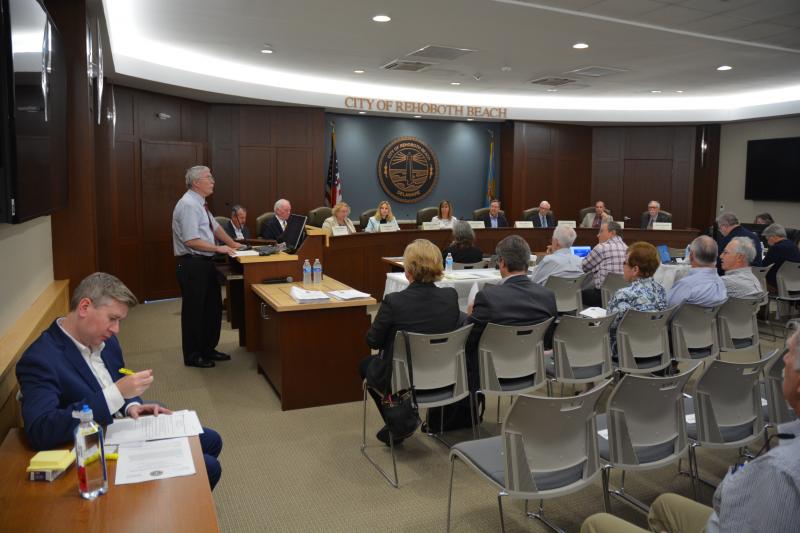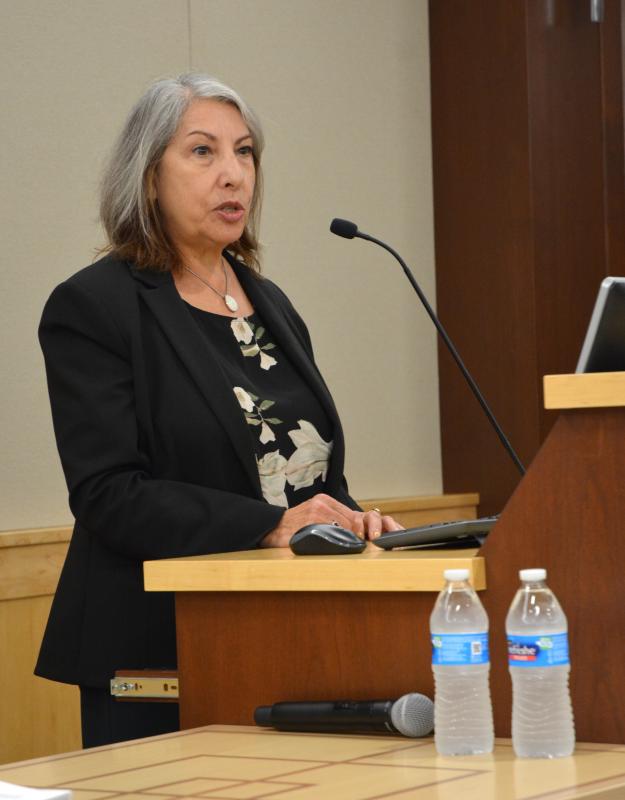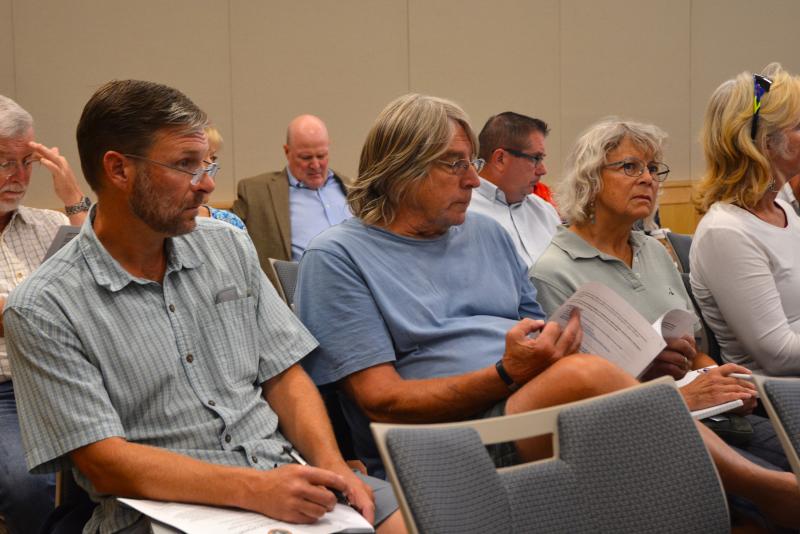Rehoboth hosts offshore wind information-gathering session
Like much of the mid-Atlantic coastline, the federal waters off the coast of Delaware have offshore wind power lease areas. The development of those areas is a decade in the making, and there are still years to go before power generation begins, as the companies that hold the leases continue to work through the federal approval process.
One of the two lease areas – Ørsted’s Skipjack Wind Farm – is due east of Rehoboth Beach, which is why city commissioners conducted an information-gathering session Sept. 27, with a number of subject-area experts. The expectation is that once all the information is considered, the city will offer an opinion on the proposed wind farms.
Panelists included US Wind Delaware Development Manager Mike Dunmyer, Ørsted representative Danni Van Drew, Caesar Rodney Institute Center for Energy & Environmental Policy Director David Stevenson, Bureau of Ocean Energy Management’s Karen Baker, Delaware Department of Natural Resources and Environmental Control’s Jennifer Holmes, Ocean City, Md. Mayor Rick Meehan and City Manager Terry McGean, University of Delaware School of Marine Science and Policy’s Dr. Jeremy Firestone and University of Delaware School of Marine Science and Policy’s Dr. Willett Kempton.
It wasn’t just the panelists and Rehoboth officials in the audience, as Speaker of the House Rep. Pete Schwartzkopf, D-Rehoboth; Lewes Mayor Andrew Williams; Dewey Beach Mayor Bill Stevens; and Henlopen Acres Mayor Joni Reich also attended.
Each panelist got 20 minutes to make a presentation followed by a brief round of questions submitted by the public asked by meeting moderator Bonnie Ram, a strategic consultant and former senior researcher at the University of Delaware.
Beginning with Baker, each panelist made their presentation.
Baker, who was appointed chief for the Office of Renewable Energy Programs three months ago, said it takes at least five years for the companies to get approval to begin building.
The closest project to Delaware, US Wind’s MarWin wind farm due east of Ocean City, Md., is in the review process for its construction and operations plan, which includes a preferred landfall connection at 3R’s Beach just north of Bethany Beach.
Baker said BOEM is reviewing the plan against the National Environmental Policy Act. She said the review should be complete by the summer of 2023 and that there are still plenty of opportunities for public comment.
Holmes, Coastal Regulatory Programs manager for DNREC, said the state has the federally delegated authority to review all alternative energy projects out to about 24 nautical miles. Both areas fall within that area and will be reviewed against state laws.
US Wind has issued a notice of completion for its plan, but the review process is in its beginning stages, said Holmes.
US Wind’s project, which is about 25 miles from Rehoboth and Dewey, has the potential to deliver 1,100 MW of power to the grid with 76 turbines, each standing between 815 feet and 940 feet tall depending on the final choice. Dunmyer said if everything goes as planned, the first 300 MW of power could be delivered in 2025, with the rest in 2026.
The lease area for US Wind’s projects hasn’t been awarded in full, which means turbines would be closer than the 25 miles when it is. In a full build out of the lease area, Dunmyer said the closest turbine would be about 21 miles from Rehoboth and Dewey, and there would 121 turbines.
Representing Ocean City, Meehan and McGean voiced their frustration in dealing with the wind power companies and the federal government.
Six years ago, when he really became aware of the lease areas, Meehan said he asked for the areas to be moved back so the turbines couldn’t be seen from shore. He said he was told the process could take three to four years.
“Not one turbine has been built at this point,” he said.
McGean said not to believe people who say projects built farther out aren’t financially viable. The projects in New York, Virginia and North Carolina are all farther out and they’re viable, he said.
Ørsted’s Skipjack project is a 966 MW project, with about 70 turbines.
Van Drew, a community relations consultant for Ørsted, said the company is evaluating near-shore survey data collected this past spring so it can complete its construction and operations plan. The company is looking to complete that by the end of the year, she said.
Stevenson said most of the economic benefits associated with wind farms will be going to Maryland and New Jersey because those states issued offshore wind renewable energy credits, known as ORECs. If anything, the loss of the viewshed due to turbines on the horizon will have a negative effect on tourism, he said.
The state may not see the economic benefits or be issuing the ORECs, but it still has considerable power because the companies want to connect through Delaware land, said Stevenson, adding there are alternatives to wind, including community solar and advanced technology.
Firestone, on hand to discuss resident and visitor attitudes, said a percentage of the population prefers wind turbines to be out of sight, but the attitude changes when asked if the turbines are part of an overall transition in energy sources.
Addressing economic increases and decreases from tourism, Firestone said there would be some losses, but there would also be gains, and in the end, it would essentially be a wash.
Kempton rounded out the presenters. He said some of the environmental benefits associated with the wind farms will be delayed, but almost immediately there will be some benefits. Within a minute of the turbines generating power, an energy plant using fossil fuels will be shut down because the electrical system has only so much capacity, he said.
Kempton warned members of the public to be wary of who is raising questions and concerns about wind farms. This technology is a threat to the business of legacy power generators, and it should be expected they’d be working to sow doubt, he said.
Given it was an information-gathering session, commissioners did not question panelists directly. However, Mayor Stan Mills concluded the meeting by saying commissioners will discuss the information at future meetings, which have not yet been scheduled.
The meeting, which is about four hours, is available to view at cityofrehoboth.civicweb.net. The panelists’ presentations are also on the same website and available to view under the document center tab. For more information, contact the city at 302-227-6181 or information@cityofrehoboth.com.
Chris Flood has been working for the Cape Gazette since early 2014. He currently covers Rehoboth Beach and Henlopen Acres, but has also covered Dewey Beach and the state government. He covers environmental stories, business stories and random stories on subjects he finds interesting, and he also writes a column called Choppin’ Wood that runs every other week. He’s a graduate of the University of Maine and the Landing School of Boat Building & Design.

























































